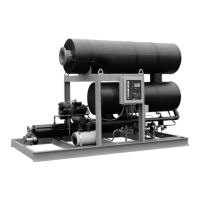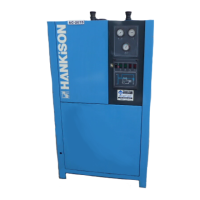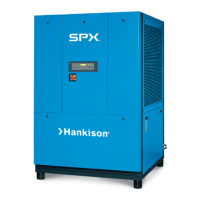14
E
N
G
L
I
S
H
(3) Close the condenser water shut-off valves
adjacent to the unit.
(4) Drain the water from the condenser. Many
models have a drain plug in the return head.
b. Disassembly
Remove the bolts or nuts, as applicable, heads and
gaskets from both ends of the condenser. Note
gasket markings, if any. Some gaskets are marked
with ridges, notches or letters. If space is limited,
the tubes can be cleaned with only one end open,
although it is difficult to flush out the clogged end
passages.
If a head gasket does not lift off from the tube
sheet and the head, do not try to pry it off. A
surface may be cut, which would cause a leak. To
free a sticking gasket, replace the head and tap it
on the outer face with a mallet or a block of wood.
After a few taps, the gasket should spring free.
c. Cleaning Procedures
Gaskets need only be rinsed in running water as
rust, scale or dirt will not generally stick firmly to
the gasket material. A rag or a soft bristle brush is
all that should be required to remove any foreign
matter.
The inside of the heads, the outer tube sheet
surfaces and the studs should be cleaned with
clear water only and a rag or a soft bristle brush. A
worn paint brush is excellent. These surfaces have
been coated with a special plastic base material, on
some models which will give years of protection
against corrosion, unless damaged. Never use a
wire brush, or a strong caustic on these surfaces.
Condenser tubes should be flushed clear with air,
water or a piece of rag on a stick or wire. In many
cases this is all that is required. If the inside sur-
faces are smooth, even though discolored, further
cleaning is not necessary. It is useless to try to get
a bright copper surface on the inside of the tubes.
They will discolor almost immediately in service,
and the condenser has been designed with an
adequate reserve for moderate fouling on these
surfaces.
If, however, a rough coating remains inside the
tubes after flushing and wiping, further cleaning is
desirable. The color of this coating varies with
water conditions, but roughness indicates cleaning
tools should be used.
A set of recommended cleaning tools is available
from the condenser manufacturer. If any other
type tool is considered, it should first be tried on a
piece of copper tubing held in a vise or flare block.
If any flakes of copper appear, or if score marks are
made inside the tube, the tool should not be used.
Never use anything with sharp or rigid edges
which could cut into the copper tubing.
When using a cleaning tool, keep the inside of the
tube wet, and move the tool slowly from one end
to the other while rotating it at a moderate speed.
A hand drill brace is recommended. If an electric
drill is used, a low speed attachment on a 1/4" size
drill is preferred. Larger units are powerful enough
to damage a tube if for any reason the cleaning
tool should stick. After one or two passes in each
tube, it should be flushed and inspected. Often
this is enough, although some deposits may
require more cleaning. In any case, stop when a
few places begin to show a copper color in each
tube.
d. Reassembly
After cleaning, wipe all foreign matter from the
tube sheets and studs. Install each gasket exactly
as it was removed. Note the gasket markings, if
any.
Install each head exactly as it was removed.
Tighten all bolts or nuts, as applicable, evenly and
firmly.
If the gaskets seal surface or ridge is damaged, and
a replacement is not immediately available, water
leaks can be stopped by removing the gasket,
drying it, and applying a thin film of a non-harden-
ing gasket sealer, such as Peratex #2, around the
seal surface or ridge. This film should be quite thin
(no thicker than the height of the seal ridge itself,
if applicable) and about 3/ 16 inch wide. Then
reassemble.
If a new gasket is put on later, be sure to remove
any grit or particles that stick to the sealer film on
the tube sheet. It is not necessary to remove all
traces of the sealer before installing a new gasket,
as long as no particles that could cut into the new
gasket remain on the surface.

